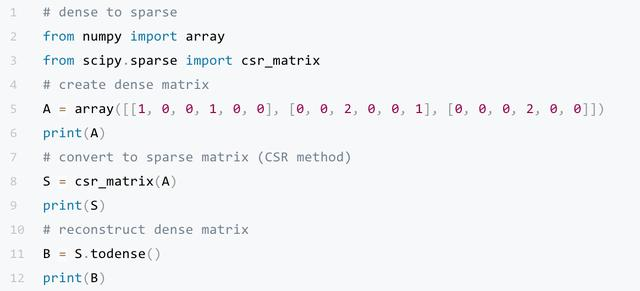scipy读取稀疏数据
转自:https://docs.scipy.org/doc/scipy-0.14.0/reference/generated/scipy.sparse.coo_matrix.tocsr.html
https://docs.scipy.org/doc/scipy/reference/generated/scipy.io.mmread.html
1.基本用法
>>> from numpy import array >>> from scipy.sparse import coo_matrix >>> row = array([0,0,1,3,1,0,0]) >>> col = array([0,2,1,3,1,0,0]) >>> data = array([1,1,1,1,1,1,1]) >>> A = coo_matrix( (data,(row,col)), shape=(4,4)).tocsr() >>> A.todense() matrix([[3, 0, 1, 0], [0, 2, 0, 0], [0, 0, 0, 0], [0, 0, 0, 1]])
直接根据行index,列index,以及data建立索引,A就是稀疏数据的类型:
<4x4 sparse matrix of type '<class 'numpy.float32'>' with 3 stored elements in Compressed Sparse Row format>
压缩稀疏行格式。
2.从文件中读取mtx格式数据并存储为稀疏格式
count内容:
%%MatrixMarket matrix coordinate integer general
4 4 4
1 1 1
1 2 1
1 1 1
2 3 1
这里针对第一行,应该是mtx文件的必要格式,需要5列内容。第二行表示的意思分别是:cols,rows,total_nums。
注意行号和列号都不是从0开始,而是从1,这和计算机中的习惯并不一样,大概是为了更多领域来用这个包吧。
from numpy import array from scipy.io import mmread count = mmread('a.mtx').T.tocsr().astype('float32') #输出: >>> count <4x4 sparse matrix of type '<class 'numpy.float32'>' with 3 stored elements in Compressed Sparse Row format> >>> count.todense() matrix([[2., 0., 0., 0.], [1., 0., 0., 0.], [0., 1., 0., 0.], [0., 0., 0., 0.]], dtype=float32)
3.对稀疏矩阵取log
from numpy import array import numpy as np from scipy.sparse import coo_matrix,csr_matrix row = array([0,0,1,3,1,0,0]) col = array([0,2,1,3,1,0,0]) data = array([1,1,1,1,1,1,1]) A = coo_matrix( (data,(row,col)), shape=(4,4)).tocsr() print(A.todense()) #A=np.log(1+A)#这样会报错 #NotImplementedError: adding a nonzero scalar to a sparse matrix is not supported A=csr_matrix(np.log(A.toarray() + 1)) print(A.todense())
不能直接取log,会报错。
需要转换为array后操作,再转换为array。
4.对稀疏矩阵的转置
接上面的代码,可以直接使用
A=np.transpose(A) #输出: [[3 0 1 0] [0 2 0 0] [0 0 0 0] [0 0 0 1]] [[3 0 0 0] [0 2 0 0] [1 0 0 0] [0 0 0 1]]
不需要转换为array就能用np的转置函数。
5.array转换为稀疏格式
https://blog.csdn.net/weixin_32597695/article/details/113489657

6.稀疏矩阵的合并
https://blog.csdn.net/qq_16912257/article/details/70888740
- 横向合并:
scipy.sparse.hstack - 纵向合并:
scipy.sparse.vstack
>>> from scipy.sparse import hstack,vstack,csc_matrix >>> import numpy as np >>> X = csc_matrix(np.arange(4).reshape(2, 2)) >>> X.toarray() array([[0, 1], [2, 3]]) >>> Y = csc_matrix(np.arange(4, 8).reshape(2, 2)) >>> Y.toarray() array([[4, 5], [6, 7]]) >>> hstack((X, Y)).toarray() array([[0, 1, 4, 5], [2, 3, 6, 7]]) >>> vstack((X, Y)).toarray() array([[0, 1], [2, 3], [4, 5], [6, 7]])
7.访问稀疏矩阵的元素
http://cn.voidcc.com/question/p-fzkdhesx-boc.html
from scipy.sparse import coo_matrix m = coo_matrix([[1, 2, 3], [4, 5, 6]]) m1 = m.tocsr() print(m.toarray()) print(m1.toarray())
coo_matrix稀疏类型不能按照下标访问,需要转换为crs系数格式存储:
[[1 2 3] [4 5 6]] [[1 2 3] [4 5 6]] >>> m[1,2] Traceback (most recent call last): File "<pyshell#0>", line 1, in <module> m[1,2] TypeError: 'coo_matrix' object is not subscriptable >>> m1[1,2] 6



 浙公网安备 33010602011771号
浙公网安备 33010602011771号